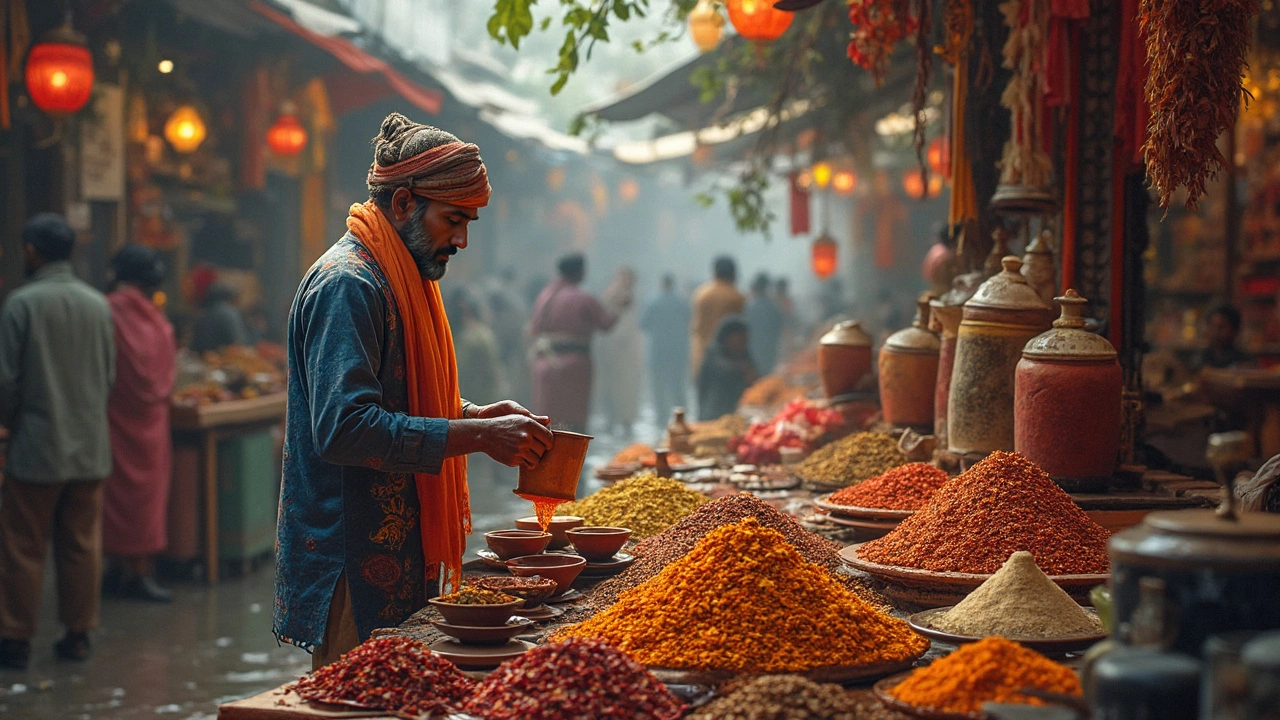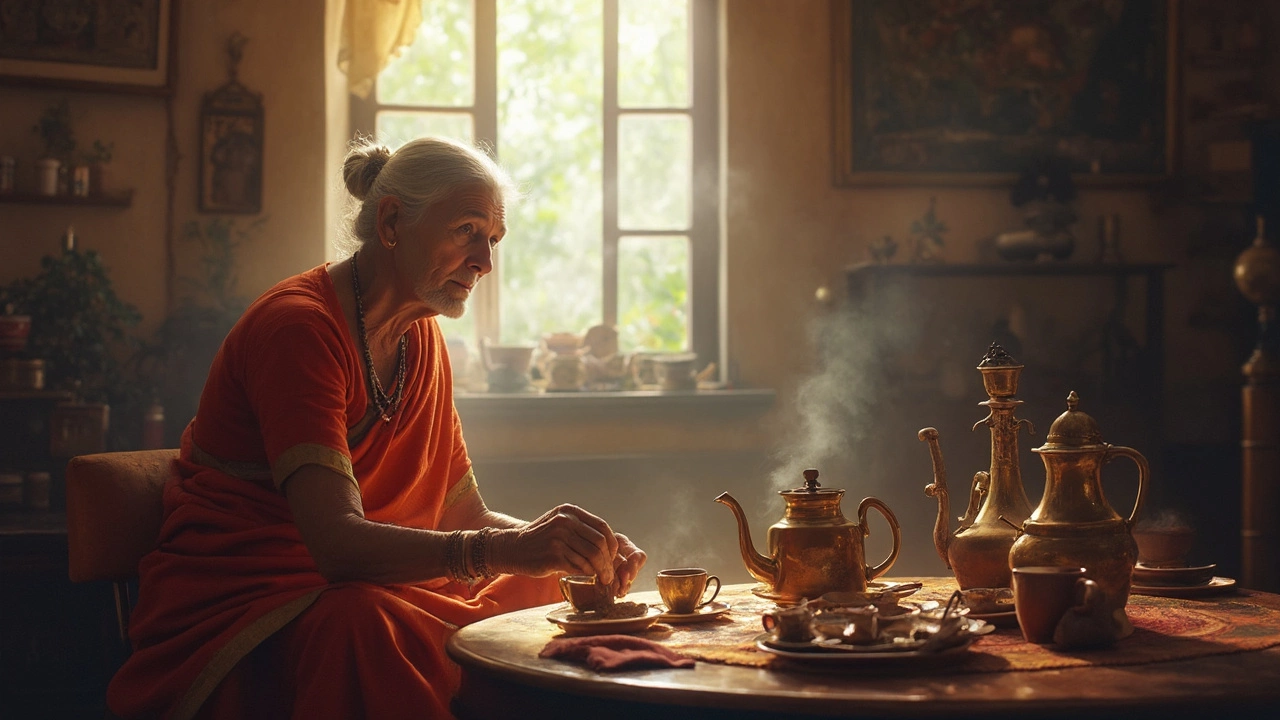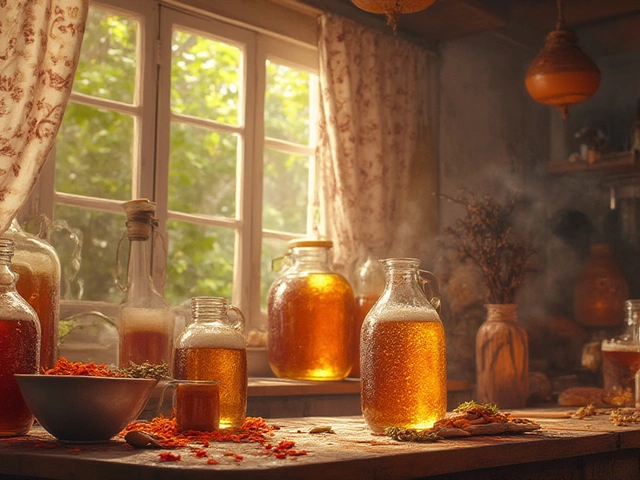
Did you ever wonder which tea rules the world? It's black tea, hands down! It’s a hot favorite, and there's a good reason for that. This robust and versatile brew is enjoyed by millions across the globe, from the busy streets of London to the quiet tea gardens of Assam. Black tea forms the base for popular blends like Earl Grey and chai, making it a staple in various cultural routines.
Green tea, not too far behind, has gained a reputation as the health tonic of the tea world. It's loaded with antioxidants and offers a gentler, grassy flavor that shouts wellness. But hey, don’t make the mistake of thinking it’s just for health freaks. Plenty of folks savor a good green tea simply for its refreshing taste.
- Global Tea Consumption Statistics
- The Reigning Champion: Black Tea
- Green Tea: Not Just for Health Nuts
- Cultural Tea Traditions Worldwide
- Tips for Tasting Different Teas
- Brewing the Perfect Cup
Global Tea Consumption Statistics
When it comes to the most loved beverage around the globe, tea sure knows how to make its mark. The numbers are pretty impressive. On average, about 6.5 billion kilograms of tea are consumed every year worldwide. Now, that's a lot of tea cups! China and India are leading the pack, not just because they're the biggest tea producers, but also because they're home to a massive population of tea enthusiasts.
Both black and green teas have their legions of fans. But if there's one standout star, it's black tea. It's the undisputed champ, capturing a significant slice of the tea-drinking pie. Interestingly enough, countries like the UK, Turkey, and Ireland have some of the highest per capita tea consumption rates. Imagine folks having around 3 to 4 cups a day, and that's on a light day!
Green tea is climbing the popularity charts too, especially with health benefits on everyone's mind. It's quite the rage in Japan and China, where traditions deeply root it into daily routines. You might find it surprising, but Morocco also loves its tea, especially the minty kind!
For those who love some fun numbers, here's a little tea tidbit for you:
| Country | Average Annual Tea Consumption per Person (kg) |
|---|---|
| Turkey | 3.16 |
| Ireland | 2.19 |
| United Kingdom | 1.94 |
Those figures show just how deeply rooted tea is in cultural rituals. From the Turkish cay to the British afternoon tea, everyone's got a favorite way to enjoy their cup. And there you have it—a quick look at what makes tea a global sensation!
The Reigning Champion: Black Tea
When it comes to tea, black tea takes the crown as the most consumed tea on the planet. This might not come as a shock when you think about the sheer variety found within this category—from the classic English Breakfast to the spiced warmth of chai.
Why Black Tea?
The secret behind black tea's popularity lies in its bold flavor and versatility. Unlike its green cousin, black tea is fully oxidized. This process heightens its rich taste and gives it a longer shelf life. Its strong flavor makes it perfect for pairing with milk, sugar, or even lemon, adapting to different taste preferences worldwide.
Global Love for Black Tea
Take a look at cultures around the world, and you'll see black tea at the heart of social rituals. In the UK, afternoon tea isn’t the same without a steaming cup of black tea. Meanwhile, in India, chai stalls line the streets, serving spiced black tea to the masses. Even in China, where green tea might seem dominant, black tea (known as 'hong cha') holds its own.
Black tea accounts for about 80%of tea consumption in the West, but it’s not just a Western preference. Its popularity spans continents, breaking cultural borders and language barriers.
| Region | Percentage of Black Tea Consumption |
|---|---|
| Western Countries | 80% |
| Asia | 45% |
| Africa | 60% |
Choosing the Right Black Tea
- Earl Grey: Perfect if you love a hint of refreshing bergamot.
- Darjeeling: Known as the "Champagne of Teas," it offers a delicate flavor perfect for afternoon sipping.
- Assam: Strong and full-bodied, ideal if you like milk in your tea.
- Ceylon: Offers a citrusy note, perfect for iced tea lovers.
Experimenting with these varieties can open up a whole new world of flavors. The key is trying different types and finding which one tickles your taste buds. So, next time you brew a cup of black tea, remember you’re part of a global community keeping this classic alive and kicking.
Green Tea: Not Just for Health Nuts
If you think green tea is just for wellness enthusiasts, think again! Sure, it's packed with antioxidants and comes with a bunch of health benefits, but there's so much to love about green tea beyond its healthy reputation.
The Japanese have been enjoying this gently flavored brew for centuries, where it's as much a part of culture as sushi and anime. Green tea ceremonies, known as 'chanoyu,' highlight the art and appreciation of this simple yet profound beverage. But what makes green tea such an international darling?
Varieties and Flavors
From delicate sencha to the more robust matcha, green tea offers a spectrum of tastes that can surprise and delight your palate. Some variants like genmaicha add roasted brown rice to the mix, giving it a toasty twist. Curious about the flavors? Try brewing different types to find your favorite.
Brewing Tips for the Best Cup
Getting the perfect cup isn't as mystical as it might seem. Here are some simple steps:
- Aim for water that's not too hot. Around 160-180°F should do the trick.
- Steep the leaves for 1-3 minutes depending on your taste preference. Longer steeping can make it bitter.
- Experiment with loose leaves rather than tea bags for a more flavorful experience.
And there you have it—a world of wonder in every cup. So whether you're sipping it for the health perks or simply savoring its unique taste, green tea really does offer something for everyone.

Cultural Tea Traditions Worldwide
Tea is much more than a drink; it’s a vital part of daily rituals and traditions around the world. From the intricate Japanese tea ceremonies to the informal, social tea gatherings in England, every culture has its unique way to enjoy tea.
The Japanese Tea Ceremony
Known as "Chanoyu," the Japanese tea ceremony is a beautiful blend of art, culture, and tradition. It involves the ceremonial preparation and presentation of tea, usually green tea, and follows a ritualistic protocol. It’s all about harmony, respect, purity, and tranquility, with each movement being deliberate and practiced.
British Afternoon Tea
Ever heard of the classic afternoon tea? It's a British institution! People savor strong black tea, often with milk and sugar, alongside delightful scones, finger sandwiches, and little pastries. It's a chance to take a break and indulge, often in a beautifully set room with delicate china.
Chinese Tea Culture
China, the birthplace of tea, has a rich and varied tea culture. The Chinese Gongfu tea ceremony is a traditional practice that emphasizes savoring the flavor of tea. It involves brewing tea leaves in small pots and serving it in tiny cups, focusing on precision and mindfulness.
Moroccan Mint Tea Ritual
In Morocco, mint tea is a sign of hospitality. It’s served hot, sweet, and refreshing. The tea is poured from a height into small glasses, creating a frothy top. This pouring technique isn't just for show—it helps mix the flavors!
These traditions highlight how tea tasting isn’t just about drinking—it’s experiencing a piece of culture. So next time you sip your favorite brew, think about the global journey that brought it to your cup!
Tips for Tasting Different Teas
If you've ever been curious about becoming a tea connoisseur, it's easier than you might think! Tasting different tea types is all about paying attention to your senses. So how do you get started?
Preparation Is Key
First thing, you’ve got to brew it right. It might be tempting to just wing it, but trust me, getting the water temperature and steeping time right makes a huge difference. For black tea, boiling water around 100°C is your best bet, while green tea prefers cooler water around 70°C to 80°C. Going hotter can make it bitter, and nobody wants that!
Look, Smell, Taste
Before you take a sip, take a moment to observe the color of the tea. Black teas usually have a deep amber hue, while green teas range from pale yellow to a vibrant green. Give it a sniff—aroma plays a big part in the tasting experience. The scent can range from floral and sweet to earthy and smoky, depending on the type. Now take a sip, and let it sit in your mouth to identify different notes. Are you picking up any floral hints or nutty undertones?
Keep a Journal
As you experiment, keep track of your findings in a journal. Note down what you like or dislike about each tea. After a while, you might spot patterns in flavors you prefer, which can guide new purchases or gifts for fellow tea lovers.
Tasting with Friends
Tasting different teas can be a fun social activity too. Invite some friends over and try arranging a mini-tasting session. Everyone's palate is different, which makes for interesting discussions. You might even discover new tea types you hadn’t thought about trying.
If you're feeling adventurous, try comparing teas from different tea producing regions. A Darjeeling might have a completely different profile compared to a Ceylon. Who knew there was so much depth in those little leaves?
Brewing the Perfect Cup
So, you want to brew the perfect cup of tea, huh? Whether you're working with black tea or green tea, the basics are pretty much the same. But here's where the magic happens: each tea type has its own perfect brewing method. Let's break it down.
Black Tea
Strong and bold, black tea loves hot water and a bit of time. For best results:
- Boil your water to around 212°F (100°C).
- Pour the hot water over the tea leaves and let it steep for 3-5 minutes.
- Be sure to strain the leaves or remove the tea bag right on time to avoid bitterness.
Tip: Want something a bit smoother? Try adding milk or sugar!
Green Tea
No need to boil this one to death. Green tea needs a gentler touch. Here's what you do:
- Heat water to about 160-180°F (70-80°C).
- Let the tea steep for just 2-3 minutes.
- Too long and it gets bitter, so keep an eye on the clock.
Notice the times and temperatures differ? That's because tea types react differently to heat. Dial it in, and you'll notice the aromas and flavors really pop.
Pro Tips
- Always use fresh, filtered water for a cleaner taste.
- Pre-warm the teapot or cup by swirling some hot water around it, and then pouring it out. It helps maintain the brew's temperature.
- Remember, tea gets stronger the longer it steeps, so adjust to your taste.
Whether you’re enjoying a quiet afternoon poring over a book or entertaining friends, knowing how to brew each type of tea to perfection can really elevate the experience. So, why not give it a shot?





Categories